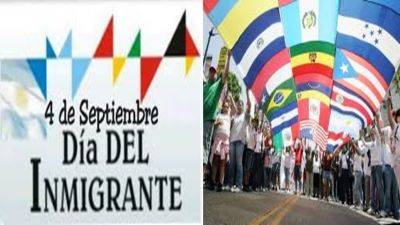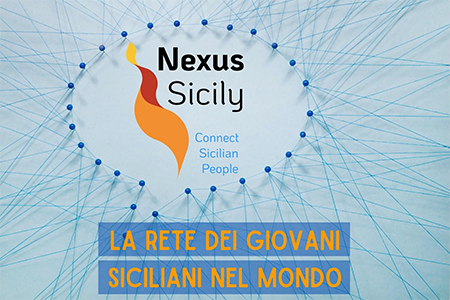 “IL GIORNO DEGLI IMMIGRATI” IN ARGENTINA OVVERO LA FESTIVITÀ PIÙ ANONIMA DELLA QUARANTENA
“IL GIORNO DEGLI IMMIGRATI” IN ARGENTINA OVVERO LA FESTIVITÀ PIÙ ANONIMA DELLA QUARANTENA
Spesso pensiamo che la emigrazione sia uguale in tutto il mondo, però ogni paese ha aspetti diversi che non si vedono dall’estero.
Nel suo nuovo articolo Paolo Cinarelli ci fa vedere diversi volti della realtà dell’emigrazione in Argentina. Spesso pensiamo che sia uguale in tutto il mondo, però ogni paese ha aspetti diversi che non si vedono dall’estero. Paolo parla prima del “día del inmigrante” (Il giorno dell’immigrante) che quest’anno ha dovuto essere festeggiato in modo ridotto per l’emergenza Covid-19, ma che da anni sta perdendo il suo significato. Possiamo solo sperare che la comunità italiana trovi il modo giusto di valorizzare questa manifestazione perché i nostri parenti ed amici in quel paese compongono il 52% della popolazione ed è giusto che riconoscano le loro origini nel modo degno. L’altro aspetto che Paolo ci fa capire è quello particolare del Sud America, la popolazione indigena che spesso è nomade e quindi incarna un altro aspetto del fenomeno dell’emigrazione che è giusto considerare. Infatti, in questo articolo Paolo ci fa vedere come la Storia di ogni paese è sempre sorprendente e solo quando abbiamo l’opportunità di vederla, come in questo articolo, ci rendiamo conto che la Storia è davvero infinita nelle sue variazioni. Nel ringraziare Paolo per questo articolo ripetiamo il nostro invito a tutti i lettori a inviare le loro storie personali da immigrati o figli/discendenti di immigrati italiani a: Questo indirizzo email è protetto dagli spambots. È necessario abilitare JavaScript per vederlo..
“IL GIORNO DEGLI IMMIGRATI” IN ARGENTINA OVVERO LA FESTIVITÀ PIÙ ANONIMA DELLA QUARANTENA
di Paolo Cinarelli - Venerdì 4 settembre in Argentina si è celebrato in modo quasi anonimo una festività ormai dimenticata ma che in fondo non è mai stata celebrata veramente, si tratta del “día del inmigrante”, il giorno dell’immigrante, in base a quanto decretato nell’anno 1949 dall’allora presidente Juan Peron. In pochissimi comuni si continua a festeggiare con qualche sfilata in costume, ma senza dubbio la più famosa di tutte le feste dell’Argentina è quella che si svolge a Oberá nell’estremo nordest del Paese. Quest’anno si svolge in versione ridotta con il nome di “Oberá Inmigrantes”, come ricorda Chiara Forni dell’associazione emilianoromagnola Nettuno di Misiones. Per un giorno l’hashtag #diadelinmmigrante l’ha fatta da padrone ed è stato in testa alle tendenze in tutte le reti. L’argomento dell’origine della popolazione del paese resta ancora tenuto all’oscuro. Alcuni dicono sia dovuta alle successive ondate migratorie e altri invece lo vogliono ridurre all’arrivo dei conquistadores, i conquistatori e del loro genocidio sulle popolazioni locali precolombiane chiamate “pueblos originarios”, in linea con la nuova terminologia voluta dai revisionisti. I primi sostengono che più del 95% della popolazione sia di origine europea e di loro oltre la metà è composta da oriundi italiani, per i secondi invece l’origine indigena sussiste in quasi il 60% degli argentini. A questo punto la logica del pensiero binario riduce ogni concetto a una più semplice questione sulla percentuale della composizione genetica, tanto per potere predominare sull’opzione contraria. La versione storica ufficiale risolve tutto con la Rivoluzione del 1810, le Guerre di Indipendenza e le prodezze epiche dei loro generali costituenti. Ma lo sfondo storico invece è ben più ampio, dal 1853 la Costituzione argentina estende garanzie e scopi anche “para todos los hombres del mundo que quieran habitar en el suelo argentino”, letteralmente, a tutti le persone del mondo che vogliano vivere sul suolo argentino. Anche l’articolo 25 recita che “il Governo Federale incentiva l’immigrazione europea e non può limitare né gravare con alcun tributo l’ingresso nel territorio argentino degli stranieri che abbiano come obiettivo il lavoro della terra, lo sviluppo industriale, portare e insegnare scienze e arti”. La data del 4 settembre è ancora anteriore in quanto ricorda la decisione del Triumvirato, il primo embrionale potere esecutivo dell’Argentina, che nel 1812 garantì ufficialmente “immediata protezione agli individui di tutte le nazioni e alle loro famiglie che desiderino vivere in Argentina”. A condizione, veniva chiarito, di non turbare la società e rispettare le leggi del paese. Questo era di fatto il primo riconoscimento del fenomeno dell’immigrazione, che avrebbe poi cambiato per sempre l’Argentina. Resta il fatto che le civiltà precolombiane erano anch’esse migranti in quanto nomadi, seppur sempre in un’area delimitata, per arrivare alla situazione attuale in cui il fenomeno migratorio è così articolato che gli spostamenti tra province e regioni coesistono con altri verso la capitale provenienti da tutto il paese. “I migranti meritano molto di più di quanto questo Paese gli riconosce – diceva Roberto Carolei nel suo programma radio Tanos – perché ho sentito e visto diversi programmi e telegiornali e in nessuno hanno fatto riferimento a questa festività così importante che è il giorno dell’immigrante. In Argentina i conduttori, giornalisti e anche politici di ogni livello sono figli o nipoti di immigranti. Io penso che questa mancanza di identità ci porta a commettere errori a livello sociale, credo che riscoprendo la nostra identità troveremo i valori che portavano questi immigranti che hanno costruito l’Argentina”.
“THE DAY OF THE IMMIGRANTS”, ARGENTINA’S MOST ANONYMOUS FESTIVITY OF THE QUARANTINE
We often think migration is the same around the world but every country has different issues that cannot be seen from overseas. In his new article Paolo Cinarelli let us see different faces of the reality of migration in Argentina. We often think migration is the same around the world but every country has different issues that cannot be seen from overseas. Firstly he speaks about the “día del inmigrante” (the day of the immigrant) that this year had to be celebrated in a reduced form due to the Covid-19 emergency but which for years had been losing its meaning. We can only hope that the Italian community finds the right way to give value to this event because our relatives and friends make up 52% of the country’s population and it is proper that they recognize their origins in a worthy way. The other issue that Paolo lets us understand is one that is particular to South America, the indigenous population that is often nomadic and therefore embodies another aspect of the phenomenon of migration that is right to consider. In fact, in this article Paolo let us see how the history of every country is always surprising and only when we have the chance to see it, as we do in this article, do we realize that history truly has an infinity of variations And in thanking Paolo for this article we repeat our invitation to all our readers to send us their personal stories as migrants or children/descendants of Italian migrants to: Questo indirizzo email è protetto dagli spambots. È necessario abilitare JavaScript per vederlo..
“THE DAY OF THE IMMIGRANTS”, ARGENTINA’S MOST ANONYMOUS FESTIVITY OF THE QUARANTINE
By Paolo Cinarelli - On Friday September 4 Argentina celebrated in an almost anonymous way an event that is now forgotten and that basically has not really been celebrated. This is the “día del inmigrante”, the day of the immigrant, in accordance with the 1949 decree by then President Juan Peron. Very few local councils continue to celebrate the day with some parades in costume but without a doubt the most famous of all these celebrations in Argentina is held in Oberá in the extreme north-east of the country. This year it was held with the name “Oberá Inmigrantes” and in a reduced form as Chiara Forni of the Emilia-Romagna Association reminded us. For one day the hashtag #diadelinmmigrante dominated and led all the trends on all the networks. The argument about the origin of the country’s population is still obscure. Some say that it was due to successive waves of migrants and on the other hand others want to reduce it to the arrival of the Spanish conquistadores, the conquerors, and their genocide of the local pre-Columbian populations called the “pueblos originarios” (original peoples) in line with the new terminology wanted by the revisionists. The former sustain that more than 95% of the country’s population is of European origin and of these more than half is made up of Italian oriundi (descendants) and the latter declare that those of indigenous origins make up almost 60% of the Argentineans. At this point the logic of the binary thinking reduces every concept to a simpler question of the percentage of the genetic composition just to be able to predominate over the opposing option. The official historical version resolves everything with the 1810 Revolution, the Wars of Independence and the epic feats of the constituent generals. But the historical background is much wider since Argentina’s Constitution of 1853 extends guarantees and purposes also to “para todos los hombres del mundo que quieran habitar en el suelo argentino”, literally to all the people in the world who want to live on Argentinean soil. Article 25 also states that “the Federal Government encourages European immigration and cannot limit or burden with any entry tax into Argentinean territory any foreigners who have as their objective working the land, industrial development and to bring and teach the sciences and art”. The date of September 4 is even earlier than this because it recalls the decision of the Triumvirate, the first embryonic executive power in Argentina, that in 1812 officially guaranteed “immediate protection to individuals of all the nations and their families who wish to live in Argentina” Provided, it was clear, that they did not disturb the society and respected the country’s laws. This was in fact the first recognition of the phenomenon of immigration that would then change Argentina forever. The fact remains that the Pre-Columbian civilizations were also migrants in that they were nomads, even if always in a defined area, to arrive at the current situation in which the phenomenon of migration is so articulated that movements between provinces and regions co-exist with others towards the capital from all the country. “Migrants deserve more than what this country recognizes,” said Roberto Carolei in his Tanos radio programme, “Because I heard and saw various programmes and television news services and none made any reference to the day of the Immigrant that is such an important celebration. In Argentina the presenters, journalists and even politicians of every level are children and grandchildren of immigrants. I think that this lack of identity leads us to make errors on a social level and I believe that by rediscovering our identity we will find the values that these immigrants who built Argentina brought”



